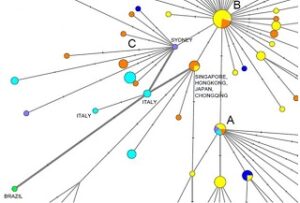
Weak ties and the pandemic
The weak ties are important in the theory of networks as we already showed in the previous post because they are the ones that can dynamize the networks and make them leave their niches and walk around others, but how is this on social media is the most interesting.
showed in the previous post because they are the ones that can dynamize the networks and make them leave their niches and walk around others, but how is this on social media is the most interesting.
What Mark Gronovetter, a professor of sociology at Stanford University demonstrated with his article entitled The Strength of Weak Ties, is that not only does the quality of relationships between friends and family matter, quantity also matters, and this will be reflected in a another curious article by Duncan Watts and Stevie Strogatz.
They started to work with entomologist Tim Forrest to try to understand why the crickets at one time sang in unison when they reached a certain number of these insects in the forest, they also wanted to understand if this is related to the so-called six degrees of separation of the nets.
In perfectly regular networks, the neighbors of each node tend to be connected to each other, and this local redundancy, or “grouping”, acts as a natural stoppage of the spread, for example, of a virus, clearly, if all neighbors of an infected node are also already infected, the disease will have few places to go if they are isolated, already in a random network, means that all neighbors are likely to be infected.
The results seemed obvious, but what they found is that it is less obvious that when only a fraction of links on a regular network are randomly linked, diseases can spread almost also when on a random network, so by the theory of networks only Complete isolation from the grid can prevent contagion.
Their 1998 article in Nature, “Colletive dynamics of ´small-word´ networks” demonstrated the effect they have on a large scale from small worlds with six degrees of separation, and their influence for the current pandemic is that social isolation is necessary, and even more necessary would be the initial foci of the pandemic now spread throughout the country, and in few parts of the world there have been effective measures against its spread
However the Watts-Strogatz model is not generic, as there is a need for a fixed number of nodes, and thus it cannot be used for an expanding network, another model was made later by Barabasi and Reka Albert, called free-scale , this model also has limitations as it cannot work with high levels of nodes in real networks, so it also has limits to analyze, for example, a pandemic that affects millions of people worldwide.
What these historical works of analysis of social networks infer about the pandemic is that at a time when the pandemic has already become widespread, that is, the Barabási / Albert free scale, it is no longer possible to control only outbreaks and a protection measure on a large scale it is necessary, in short, broad social isolation.
It is clear that economic pressure should not leave this, and so the use of vaccine becomes essential, but what ?









